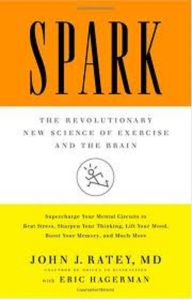Spark by John J. Ratey, MD
- Dec
- 29
- Posted by Sue Stokes-Nash
- Posted in Book Resources, Resources
 I was first introduced to the book, Spark, by my son’s Board Certified Behaviour Analyst (BCBA). He was giving a presentation to a group of parents on anxiety and how exercise can help people living with Autism, who often also experience anxiety.
I was first introduced to the book, Spark, by my son’s Board Certified Behaviour Analyst (BCBA). He was giving a presentation to a group of parents on anxiety and how exercise can help people living with Autism, who often also experience anxiety.
A few of my personal highlights that the author, John Ratey, shares in his book:
“The real reason we feel so good when we get our blood pumping is that it makes the brain function at its best.” (pg. 3)
“What neuroscientists have discovered in the past five years alone paints a riveting picture of the biological relationship between the body, the brain, and the mind.” (pg. 4)
“I’ll explain the science of how exercise cues the building blocks of learning in the brain; how it affects mood, anxiety, and attention; how it guards against stress and reverses some of the effects of aging in the brain. These are tangible changes measured in lab rats and identified in people.” (pg. 4 & 5)
“It turns out that moving our muscles produces proteins that travel through the bloodstream and into the brain, where they play pivotal roles in the mechanisms of our highest thought processes.” (pg. 5)
“Why should you care about how your brain works? For one thing, it’s running the show. Right now the front of your brain is firing signals about what you’re reading, and how much of it you soak up has a lot to do with whether there is a proper balance of neurochemicals and growth factors to bind neurons together. Exercise has documented, dramatic effect on these essential ingredients.” (pg. 6)
“I want to cement the idea that exercise has a profound impact on cognitive abilities and mental health.” (pg. 7)
The first chapter of this book introduces the reader to Naperville Central High School (in Illinois, west of Chicago), a great example where exercise is applied to increase both muscle AND brain power:
“It is 7:10 am, and for the small band of newly minted freshmen lounging half asleep on the exercise equipment, that means it’s time for gym. A trim young physical education teacher named Neil Duncan lays out the morning’s assignment: ‘OK, once you’re done with your warm-up, we’re going to head out to the track and run the mile,’ he says, presenting a black satchel full of chest straps and digital watches – heart rate monitors of the type used by avid athletes to gauge their physical exertion.” (pg. 9)
“This is not good old gym class. This is Zero Hour PE, the latest in a long line of educational experiments conducted by a group of maverick physical education teachers who have turned the nineteen thousand students in Naperville District 203 into the fittest in the nation – and also some of the smartest.” (pg. 10)
“The more neuroscientists discover about this process, the clearer it becomes that exercise provides an unparalleled stimulus, creating an environment in which the brain is ready, willing, and able to learn.” (pg. 10)
“The administration is so impressed that it incorporates Zero Hour into the high school curriculum as a first-period literacy class called Learning Readiness PE. And the experiment continues. The literacy students are split into two classes: one second period, when they’re still feeling the effects of the exercise, and one eighth period. As expected, the second-period literacy class performs best.” (pg. 12)
John Ratey goes on to explain how exercise helps many other health issues. He has a chapter on each of the following: learning, stress, anxiety, depression, attention deficit (ADHD), addiction, hormonal changes, and aging.
I’ve witnessed the positive impact of exercise with my own son. High intensity exercise helps him feel less anxious and stay focussed longer – two things he struggles with. As well, he feels better physically. And this book explains why.
I am intrigued by Naperville Central High School’s experiments. Wouldn’t it be amazing if we could incorporate this type of program into all of our schools?